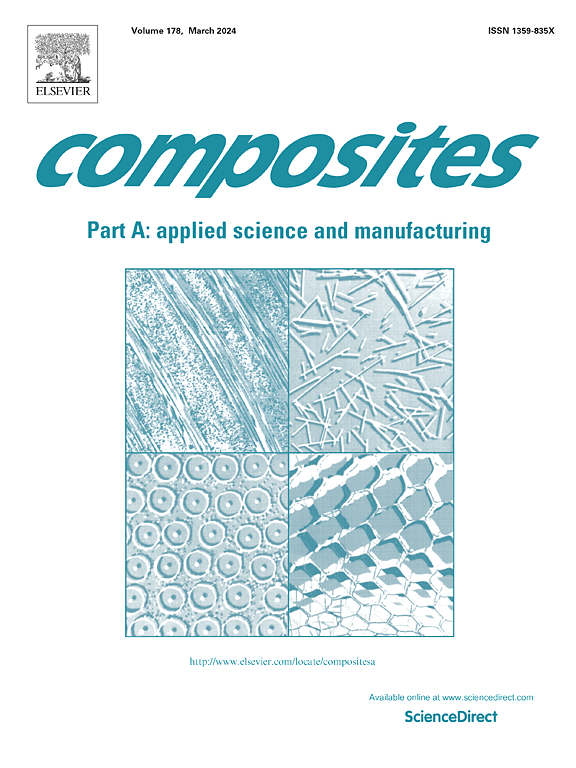Boosted high-temperature capacitive energy storage in D-A-D type semiconductor/polymer composite via constructing physical cross-linking and electronic trapping
IF 8.1
2区 材料科学
Q1 ENGINEERING, MANUFACTURING
Composites Part A: Applied Science and Manufacturing
Pub Date : 2025-05-09
DOI:10.1016/j.compositesa.2025.109019
引用次数: 0
Abstract
Nowadays, with the development of hybrid electric vehicles, aerospace, underground oil and gas exploration, and other fields, the demand for high-temperature dielectric energy storage equipment has rapidly increased. Although engineering aromatic polymers with high glass transition temperatures (Tg) have been developed, it is extremely urgent to solve the problem of the sharp decline in energy storage performance caused by the exponentially increased leakage current under high temperatures and electric fields. This work incorporates a semiconductor molecule with donor–acceptor-donor configuration (DPP-S) into the PEI matrix to achieve significantly enhanced high-temperature capacitive performance. The dense physical cross-linking networks are formed by the electrostatic interaction between the positively charged phenyl group in PEI and the electron-donating thiophene group in DPP-S, as well as the hydrogen bonding interaction between the amide group in DPP-S and the −C=O group in the PEI chain. This molecular interface effect improves mechanical strength to boost the breakdown strength and introduces trap sites capturing charge carriers to suppress leakage current. Consequently, excellent energy storage performance is achieved in PEI-DPP-S-0.2 wt%, e.g., discharge energy density of 4.87 J cm−3 at 150 °C and 3.45 J cm−3 at 200 °C with high discharge efficiency of 90 %, surpassing lots of high-temperature energy storage polymers. Finally, PEI-DPP-S-0.2 wt% exhibits stable performances during ultralong 105 charge–discharge cycles in harsh environments (200 MV m−1 and 200 °C) and prospects for large-scale preparation. This work further deepens the insight of high-temperature dielectric energy storage enhanced by molecular interface engineering.
通过构建物理交联和电子俘获,提高了D-A-D型半导体/聚合物复合材料的高温电容储能性能
如今,随着混合动力汽车、航空航天、地下油气勘探等领域的发展,对高温介质储能设备的需求迅速增加。虽然已经开发出具有高玻璃化转变温度(Tg)的工程芳香族聚合物,但在高温和电场作用下,泄漏电流呈指数级增长导致储能性能急剧下降的问题亟待解决。这项工作将具有供体-受体-供体结构(DPP-S)的半导体分子纳入PEI矩阵,以实现显着增强的高温电容性能。PEI中带正电的苯基与DPP-S中的给电子噻吩基团之间的静电相互作用,以及DPP-S中的酰胺基团与PEI链中的- C=O基团之间的氢键相互作用形成了致密的物理交联网络。这种分子界面效应提高了机械强度以提高击穿强度,并引入捕获电荷载流子的陷阱位点以抑制泄漏电流。因此,在0.2 wt%的倍率下,pei - dpp - s具有优异的储能性能,例如,在150°C和200°C下,放电能量密度分别为4.87 J cm−3和3.45 J cm−3,放电效率高达90%,超过了许多高温储能聚合物。最后,PEI-DPP-S-0.2 wt%在恶劣环境(200 MV m−1和200°C)下的超长105次充放电循环中表现出稳定的性能,并具有大规模制备的前景。这项工作进一步加深了对分子界面工程增强的高温介质储能的认识。
本文章由计算机程序翻译,如有差异,请以英文原文为准。
求助全文
约1分钟内获得全文
求助全文
来源期刊

Composites Part A: Applied Science and Manufacturing
工程技术-材料科学:复合
CiteScore
15.20
自引率
5.70%
发文量
492
审稿时长
30 days
期刊介绍:
Composites Part A: Applied Science and Manufacturing is a comprehensive journal that publishes original research papers, review articles, case studies, short communications, and letters covering various aspects of composite materials science and technology. This includes fibrous and particulate reinforcements in polymeric, metallic, and ceramic matrices, as well as 'natural' composites like wood and biological materials. The journal addresses topics such as properties, design, and manufacture of reinforcing fibers and particles, novel architectures and concepts, multifunctional composites, advancements in fabrication and processing, manufacturing science, process modeling, experimental mechanics, microstructural characterization, interfaces, prediction and measurement of mechanical, physical, and chemical behavior, and performance in service. Additionally, articles on economic and commercial aspects, design, and case studies are welcomed. All submissions undergo rigorous peer review to ensure they contribute significantly and innovatively, maintaining high standards for content and presentation. The editorial team aims to expedite the review process for prompt publication.
 求助内容:
求助内容: 应助结果提醒方式:
应助结果提醒方式:


